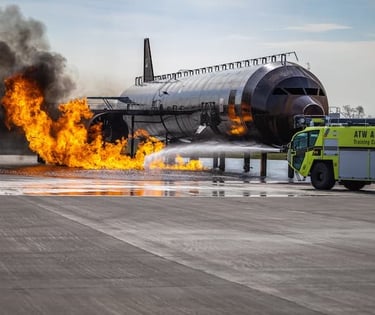
Blog
Airport Rescue and Fire Fighting (ARFF) Services and Their Coordination with the Control Tower (ATC)
How Does the Rescue and Fire Fighting Team Work Hand-in-Hand with the Control Tower to Ensure Aircraft and Passenger Safety?
How Does the Rescue and Fire Fighting Team Work Hand-in-Hand with the Control Tower to Ensure Aircraft and Passenger Safety?


Introduction
Airport Rescue and Fire Fighting (ARFF) services are a critical component of aviation safety. These specialized emergency response teams are responsible for responding to aircraft incidents, including fires, crashes, or any other emergencies occurring on or near airport premises. Effective coordination between ARFF units and Air Traffic Control (ATC) is essential to ensure rapid response times, efficient resource deployment, and ultimately, the safety of passengers, crew, and ground personnel.
This article explores in detail how ARFF teams operate, their key responsibilities, and how they work hand-in-hand with ATC to maintain high levels of safety at airports around the world.
1. Understanding ARFF Services
What is ARFF?
ARFF stands for Aircraft Rescue and Fire Fighting. It refers to a specialized category of firefighting that focuses on aircraft emergencies. Unlike traditional fire departments, ARFF teams are trained and equipped specifically to handle aviation-related incidents, which often involve flammable fuels, hazardous materials, and large numbers of people in confined spaces.
Key Responsibilities of ARFF Teams
- Rapid response to aircraft emergencies on runways, taxiways, and aprons.
- Fire suppression using specialized equipment and chemicals.
- Search and rescue operations inside aircraft wreckage.
- Hazard mitigation, including fuel spills, electrical fires, and chemical leaks.
- Assistance during aircraft evacuations and medical emergencies.
- Post-incident investigation support and debriefing.
Regulatory Standards
ARFF services must meet international standards set by organizations such as:
- ICAO (International Civil Aviation Organization) – Annex 14 Volume I
- FAA (Federal Aviation Administration) – Part 139
- EASA (European Union Aviation Safety Agency) – Aerodrome regulations
These bodies mandate minimum response times, staffing levels, equipment requirements, and training protocols.
2. The Role of Air Traffic Control (ATC)
Air Traffic Control (ATC), also known as the Control Tower, is responsible for managing all aircraft movements within an airport's airspace and on its surface. In emergency situations, ATC plays a crucial role in coordinating communication between pilots, emergency responders, and airport authorities.
Key Functions of ATC During Emergencies
- Monitoring aircraft status and identifying signs of distress.
- Declaring emergencies and alerting appropriate emergency services.
- Managing air traffic flow to clear space for emergency landings.
- Communicating directly with pilots to provide guidance and updates.
- Coordinating with ARFF teams and other emergency agencies.
3. Coordination Between ARFF and ATC
The coordination between ARFF and ATC is based on clear communication, standardized procedures, and real-time situational awareness. Here’s how they work together:
A. Emergency Detection and Notification
- Pilot Communication: Pilots may declare an emergency via radio (e.g., “Mayday” or “Pan-Pan”) due to mechanical failure, weather issues, or onboard medical problems.
- ATC Observation: Controllers can detect anomalies such as erratic flight patterns, loss of radar contact, or deviation from standard approach paths.
- Automatic Alerts: Some modern control towers use systems like Runway Status Lights (RWSL) or Engineered Materials Arresting Systems (EMAS) that trigger alerts in case of runway overruns.
Once an emergency is detected, ATC immediately notifies the ARFF team via dedicated communication channels (radio, phone, or digital alert systems).
B. Declaration of Emergency and Mobilization
Upon receiving an alert, the ARFF team mobilizes immediately. ATC provides vital information such as:
- Type of aircraft involved
- Nature of the emergency (fire, engine failure, etc.)
- Estimated time of landing or crash location
- Number of passengers and crew on board
Based on this data, ARFF dispatches the appropriate number of vehicles and personnel. Response times are strictly regulated—ICAO requires ARFF to reach any point on the airport within three minutes under normal visibility conditions.
-
C. Real-Time Information Exchange
During the incident, continuous communication between ATC and ARFF is maintained through:
- Two-way radios
- Emergency frequency channels
- Digital command centers
ATC keeps ARFF updated on:
- Aircraft position and movement
- Weather changes affecting operations
- Status of pilot communications
- Runway availability post-landing
ARFF informs ATC about:
- Arrival at the scene
- On-site conditions (e.g., fire, smoke, structural damage)
- Required assistance (medical, police, de-icing crews)
-
D. Managing the Scene and Controlling Airspace
Once the aircraft lands or crashes, ATC takes immediate steps to:
- Close affected runways and taxiways
- Divert incoming flights to alternate airports
- Coordinate with ground handling to evacuate nearby areas
- Provide ARFF with safe access to the incident site
If the aircraft makes an emergency landing, ATC guides it to a designated "crash strip" or area where ARFF can respond effectively without endangering others.
E. Post-Incident Coordination
After the situation is under control, both ATC and ARFF play roles in:
- Debriefing: Sharing incident details for review and improvement.
- Documentation: Logging actions taken, communication records, and response times.
- Restoring Operations: ATC works with ARFF and airport management to reopen runways safely and resume normal operations.
4. Training and Simulation Drills
To ensure seamless coordination, ARFF and ATC regularly participate in joint drills and simulations, including:
- Mock aircraft crashes
- Fire scenarios
- Communication breakdowns
- Multi-agency responses
These exercises help identify gaps in communication, improve teamwork, and refine emergency protocols.
5. Case Study: Successful ARFF-ATC Coordination
Example: United Airlines Flight 2885 (Hypothetical Scenario)
- An aircraft reports an engine fire shortly before landing.
- ATC declares an emergency and alerts ARFF.
- ARFF deploys foam trucks and ambulances to the expected landing zone.
- ATC clears the runway and coordinates with other aircraft to avoid interference.
- The plane lands safely; ARFF applies foam and assists with evacuation.
- All passengers and crew are accounted for within minutes.
This scenario highlights how effective communication and coordination saved lives.
6. Challenges in ARFF-ATC Coordination
Despite well-established protocols, several challenges can affect coordination:
- Communication Delays: Miscommunication or language barriers.
- Weather Conditions: Poor visibility or extreme weather slows response.
- High-Traffic Scenarios: Busy airports face pressure to manage regular and emergency traffic simultaneously.
- Equipment Failures: Malfunctioning radios or alert systems can delay mobilization.
Regular audits, upgrades in infrastructure, and staff training help mitigate these risks.
Conclusion
The partnership between Airport Rescue and Fire Fighting (ARFF) teams and Air Traffic Control (ATC) is foundational to ensuring safety in aviation. Through constant communication, real-time decision-making, and mutual support, both entities work together to protect human life and minimize damage during emergencies.
Their collaboration is not just reactive but proactive—through planning, training, and technology integration, they create a robust safety net that protects millions of passengers every year.
References
- ICAO Annex 14 – Aerodromes
- ICAO DOC.9137 Part 1
- FAA Advisory Circular AC 150/5220-22 – Aircraft Rescue and Fire-Fighting Vehicles
- EASA Certification Specifications for Aerodromes (CS-ADR)
- National Fire Protection Association (NFPA) Standards for ARFF
- Various airport emergency response manuals and case studies
